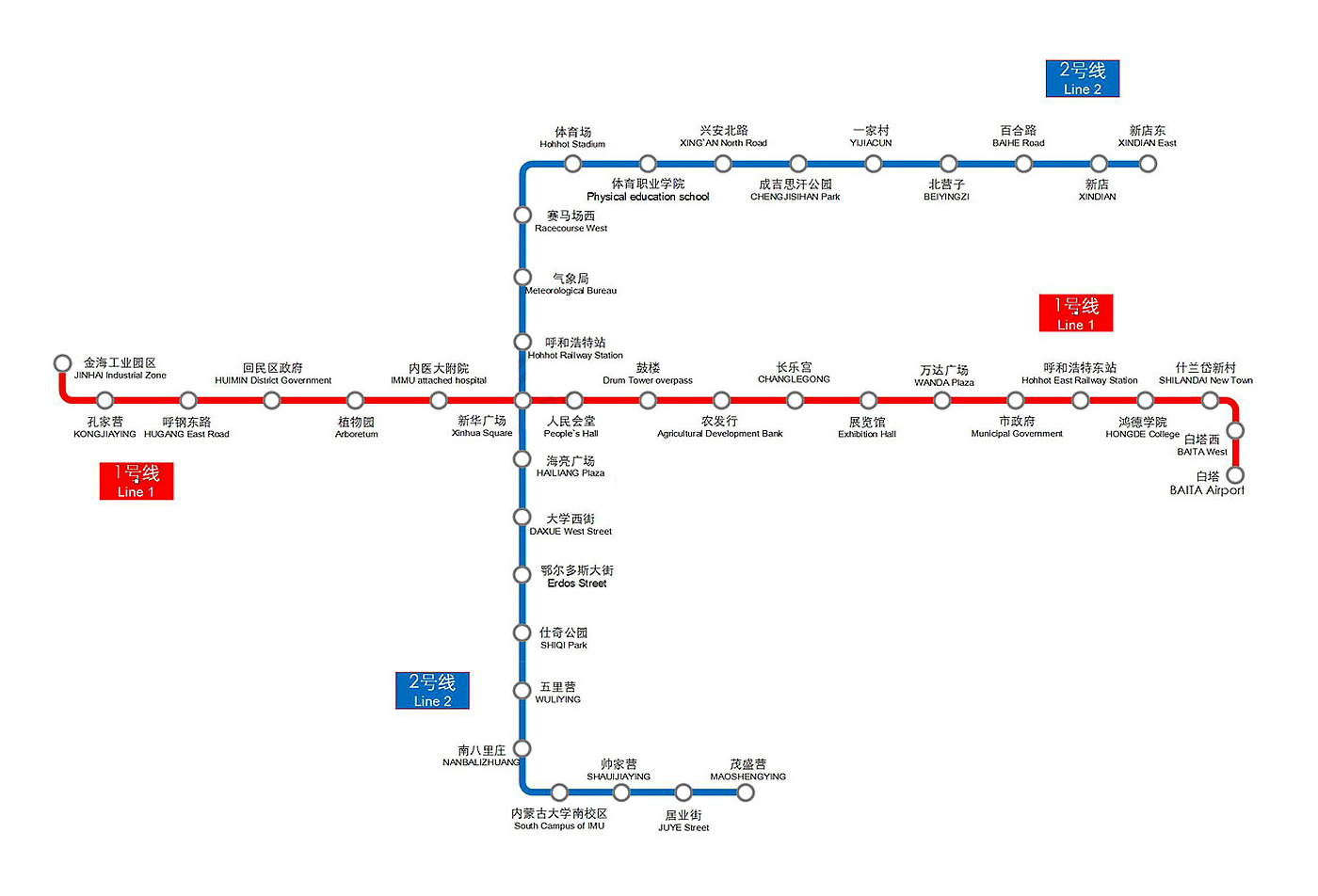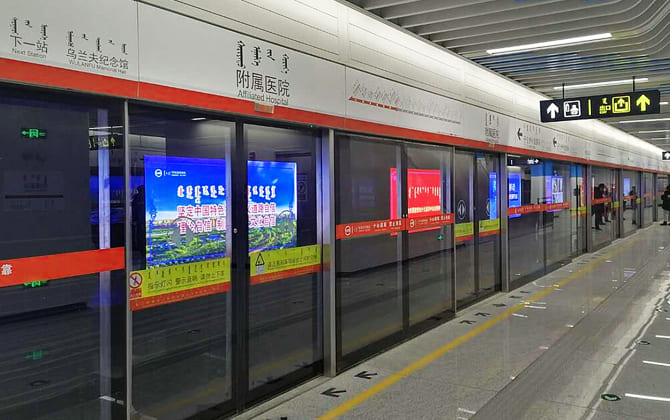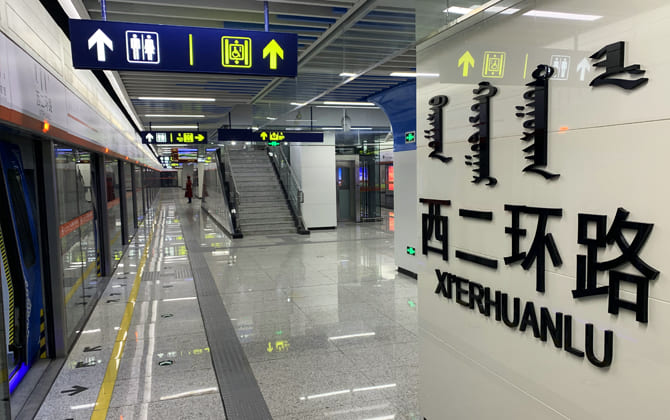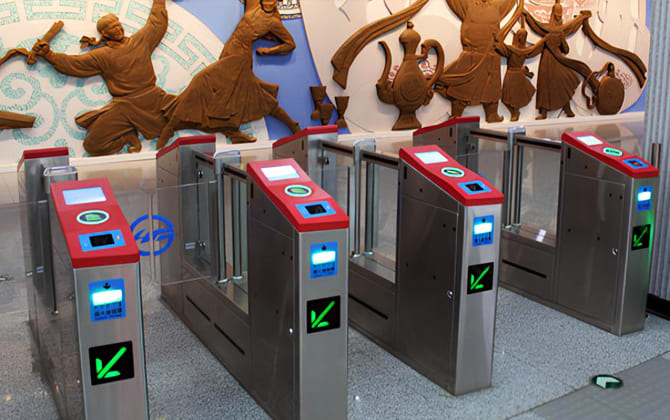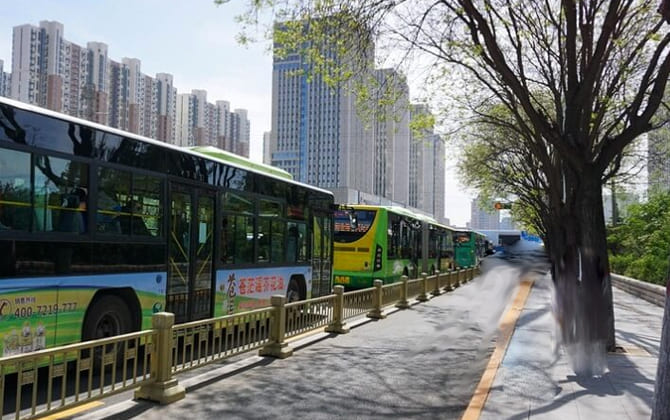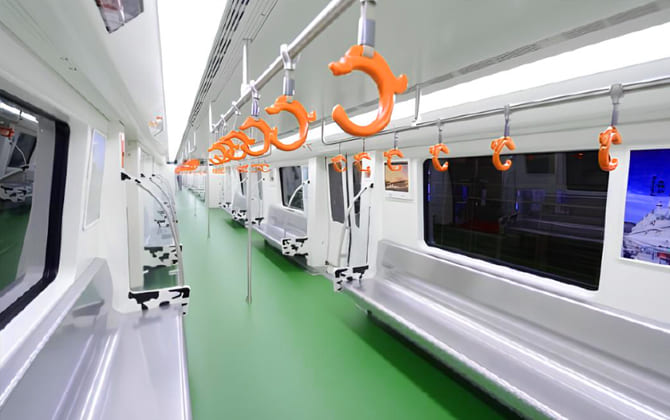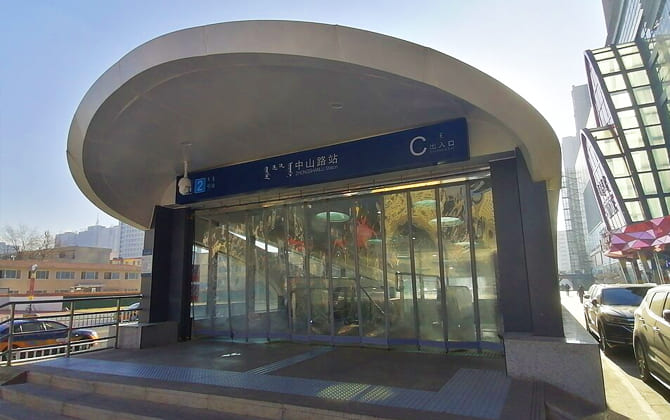Hohhot Metro (呼和浩特地铁) is the rapid transit system in Hohhot, the capital of Inner Mongolia, China. It’s the region’s first and only metro, making Hohhot the 38th city on mainland China’s metro map. Opened in late 2019, it now has two lines covering about 49 km (30 mi) and 44 stations. Line 1 runs east–west, and Line 2 runs north–south; they intersect at Xinhua Square in the city center.
The network links key hubs: Baita International Airport, Hohhot East Railway Station, the main railway station, and Inner Mongolia University. Operated by Hohhot Rail Transit Corporation, it features modern trains, bilingual Chinese–Mongolian signage, and electronic ticketing. By 2024, the metro carried an average of 211,000 passengers daily, peaking at 724,000 on December 31, 2023.
Hohhot Metro Map 2026
The 2026 map shows Lines 1 and 2, all transfer points and key landmarks. Line 1 appears in red; Line 2 in blue. Station names are in Chinese with pinyin or English, plus Mongolian script. Major stops—like Bayan (Airport) for Baita International Airport and Hohhot Railway Station for the main train hub—are highlighted. You can download the PDF from the official site.
Use the map to plan routes, view the Xinhua Square interchange, and spot future extensions shown as dashed lines. Line 1 runs east–west through inner districts into Tumed Zuoqi. Line 2 forms an “L” shape, running north–south through the city center.
Hohhot Metro Map showing different lines. Click on the map to enlarge it or download the Hohhot Subway map in PDF format.
Hohhot Metro Lines & Complete Stations List
The system has two active lines and 44 stations in total.
Line 1 – Red Line: Yili Health Valley ↔ Bayan (Airport)
Opened December 29, 2019, it runs east–west for about 21.7 km (13.5 mi) with 20 stations. It starts at Yili Health Valley in Tumed Left Banner, crosses Huimin, Xincheng and Saihan districts, and ends at Bayan near Baita International Airport. Key stops include Hohhot East Railway Station and Xinhua Square.
- Yili Health Valley
- West 2nd Ring Road
- Kongjiaying
- East Hugang Road
- West Longwangmiao
- Ulan Fu Memorial Hall
- Affiliated Hospital
- Xinhua Square
- People’s Hall
- Jiangjun Yashu
- Arts College
- Dongying Road
- Inner Mongolia Exhibition Hall
- Inner Mongolia Museum
- City Government
- Hohhot East Railway Station
- Houbutaqi
- Shilandai
- Baitaxi
- Bayan (Airport)
Line 2 – Blue Line: Arshaan Road ↔ East Tali Road
Opened October 1, 2020, it runs north–south in an L-shape for 27.3 km (17.0 mi) underground, serving 24 stations. It links East Tali Road in the north to Arshaan Road in the south via the city center. Key stops include Hohhot Railway Station, Xinhua Square, Inner Mongolia University South Campus and Inner Mongolia Gymnasium.
- Arshaan Road
- Lamaying
- Shuaijiaying
- Inner Mongolia University South Campus
- Xilin Park
- Wuliying
- Water Park
- Nuohemule
- West Daxue Street
- Zhongshan Road
- Xinhua Square
- Hohhot Railway Station
- Gongzhufu
- Hohhot Gymnasium
- Inner Mongolia Gymnasium
- Genghis Khan Square
- Haoqinying
- Genghis Khan Park
- Yijiacun
- Dong’erhuan Road
- Xincheng Library
- Baihe Road
- Xindian
- East Tali Road
All stations feature bilingual signage and automated announcements. Lines 1 and 2 intersect only at Xinhua Square. Both termini have turnaround tracks to reverse trains.
Hohhot Metro Timetable & Operating Hours
Timings Today
Service runs daily from 06:00 to around 22:30.
First trains depart both ends of Lines 1 and 2 at 06:00.
Last departures from termini start between 22:00 and 22:08.
Enter by 22:00 to catch the final train.
Metro Opening & Closing Hours
Stations open at 06:00 with first trains from Yili Health Valley, Bayan (Airport), Arshaan Road and East Tali Road.
Intermediate stops receive their first train a few minutes later.
Last trains depart all termini at about 22:00.
Stations close by 23:00 after the last train has passed.
First & Last Train Times
Line 1 (Yili Health Valley ↔ Bayan Airport): • First departures at 06:00. • Last departures at
Train Frequency
Peak hours: every 8 minutes.
Midday off-peak: every 10 minutes.
Evening (after 20:00): every 10–12 minutes.
The metro uses modern signaling to maintain safe, efficient spacing. Extra trains run during special events or holidays to ease crowds. A full trip from one end of a line to the other takes about 45 minutes, so with trains every 8–10 minutes, transfers and connections stay quick and reliable.
Hohhot Metro Ticket Prices & Fare
Fare Calculator
- Up to 5 km (3.1 mi): ¥2 (~ $0.28)
- 5–10 km (3.1–6.2 mi): ¥3 (~ $0.42)
- 10–15 km (6.2–9.3 mi): ¥4 (~ $0.56)
- 15–21 km (9.3–13.0 mi): ¥5 (~ $0.70)
- 21–28 km (13.0–17.4 mi): ¥6 (~ $0.85)
- > 28 km (> 17.4 mi): + ¥1 (~ $0.14) per extra 10 km (6.2 mi)
The longest one-way trip on Lines 1 or 2 (under 28 km/17.4 mi) costs ¥6 (~ $0.85). For example, riding Line 1 end-to-end (∼21.7 km/13.5 mi) is ¥6 (~ $0.85). Short hops of a few stations cost ¥2 or ¥3 (~ $0.28–$0.42).
Ticket Types & Payment Options
Single-ride ticket: token purchased at vending machines.
Smart card: rechargeable card with discounted fares.
Mobile payment: tap QR code or NFC on your phone.
Tap or insert your fare medium at the entry gate; the system deducts the correct amount on exit. Fare charts at all stations display prices between specific stops.
Metro Ticket Types & Day Pass Information
Single-Journey Tickets (Tokens)
Buy a token or QR ticket at machines or counters. Select your destination, pay the fare (¥2–6 / $0.28–$0.85), then tap in and drop the token at exit. Ideal for occasional riders and tourists.
Stored-Value Smart Card
Get a rechargeable Hohhot metro card (deposit required). Tap at gates for quick entry and exit. No national T-Union support—only the local card works here.
Mobile Payments (QR Code)
Use the official Metro app to generate a QR code. Scan at the gate and pay via Alipay or WeChat. No need for a physical ticket.
Concession Fare Cards
Seniors (60+): Free rides since May 1, 2026 (ID registration required).
Students: 50% off for primary, secondary and university students (show valid student ID).
Others: Active military and firefighters ride free; sanitation workers get 50% off; children under 1.3 m (4.3 ft) ride free with an adult.
Day Pass / Multi-Day Pass
No unlimited or day pass available. Pay per ride—four trips cost only ¥8–20 / $1.12–$2.80.
Purchasing & Using Tickets
Machines offer English instructions. Pay with cash or digital methods. Top up cards at counters or machines. Always tap/scan in and out—keep your ticket or card until you leave. For any issue, ask station staff for help.
Routes & Connections
Connections with Bus, Tramways & Metro to Airport
The metro links seamlessly with buses and offers a direct airport connection. No city-wide tram runs; BRT has been discontinued.
Bus Connections
Every station has nearby bus stops for last-mile links.
Hohhot East Railway Station (Line 1) served by routes 2, 3, 53, 59, etc.
Xinhua Square is a major bus hub with dozens of lines converging.
Metro to Airport
Line 1 terminus at Bayan (Airport) – 35–40 min from Xinhua Square, fare ¥5–6 (~ $0.70–$0.85).
Airport Shuttle Bus 1 – runs every 15 min, 50 min journey, fare ¥15 (~ $2.10).
City Bus 12 – all-stop service, fare ¥2 (~ $0.28).
Bus 7 (Airport Special) – 15 km (9.3 mi) route, 9 stops, fare ¥4 (~ $0.56).
Taxi – ~ ¥30 (~ $4.20) from downtown; ~ ¥20 (~ $2.80) from railway station.
For flights outside metro hours (06:00–22:30), use the shuttle bus or taxi. Always check the last train if arriving late.
Overview of Hohhot Public Transport
City Buses
Hohhot has over 100 bus routes covering all districts and suburbs. Standard fare is ¥1 (~$0.14) per ride. Some air-conditioned or longer routes charge ¥2 (~$0.28). Mini-bus routes (301, 302, 303, etc.) cost ¥1.5 (~$0.21). Buses run from about 06:00 to 20:00–21:00. Major attractions like Zhaojun Tomb and Dazhao Temple are on several routes. Many lines feed into metro stations for easy transfers.
BRT (Bus Rapid Transit)
Hohhot launched a BRT line with dedicated lanes in 2017, but it ceased operations after a few years. No BRT service is active. The city now prioritizes metro expansions and conventional buses.
Taxis and Ride-hailing
Taxis start at ¥6 (~$0.84) for the first 2 km (1.2 mi), then ¥1 (~$0.14) per additional km. App-based ride services are also available for on-demand travel outside bus and metro hours.
Intercity Transport
Hohhot is a regional transport hub with high-speed rail and an international airport. Within the city, the metro and bus network provide comprehensive coverage. For bus travel, use a transit app or map—stops display Chinese (and sometimes Mongolian) script, while metro signage is bilingual.
Bus Routes Near Stations of Hohhot Metro Line 1
- Yili Health Valley: 35, 41, Community Bus 21
- West 2nd Ring Road: 4, 8, 19, 41, 79, K1
- Kongjiaying: 4, 8, 18, 41, K1, 303
- East Hugang Road: 4, 8, 41, K1, S2
- West Longwangmiao: 3, 7, 16, 32, 41, 50, 56, 80, 81, 93, 201, S2
- Ulan Fu Memorial Hall: 4, 7, 8, 32, 59, 72, 80, 81, 93, 102, 303, K1
- Affiliated Hospital: 4, 5, 6, 8, 21, 24, 57, 59, 70, 73, 80, 81, 303, K1, K3
- Xinhua Square: 5, 24, 57, 60, 70, 71, 72, 84, 201, K1, K2
- People’s Hall: 3, 4, 5, 19, 20, 23, 26, 28, 29, 37, 58, 59, 72, 76, 82, 85, 97, K1, K4
- Jiangjun Yashu: 3, 4, 5, 19, 29, 59, 82, 95, 97, K1
- Arts College: 19, 33, 36, 75, 78, 88, 92
- Dongying Road: 3, 19, 27, 29, 33, 53, 66, 75, 92, 95, 97, K1
- Inner Mongolia Exhibition Hall: 3, 5, 27, 29, 53, 56, 62, 66, 75, 92, 95, 97, K1
- Inner Mongolia Museum: 2, 3, 5, 16, 23, 27, 29, 53, 72, 106, S35
- City Government: 2, 3, 16, 23, 27, 53, 59, 102, 103, 113, 118, S24, S39
- Hohhot East Railway Station: 2, 5, 12, 28, 59, 80, 83, 100, 101, 113, 118, 121, 301
- Houbutaqi: 12, 53, 96, 113, 301, S16
- Shilandai: 12, 53, 96, 113, 118, 301, S16, Community Bus 31
- Baitaxi: 12, 113, 118, 301, S16, Community Bus 31
- Bayan (Airport): 12, 13, 97, 113, 118, 125, 126, Community Bus 31
Bus stops display route numbers in Chinese (and sometimes Mongolian). “K” routes are express, “S” routes are suburban, and Community Bus lines use shuttle vans. Most buses run until around 21:00; after that, consider a taxi connection.
Facilities & Services
Hohhot Metro Station Parking Charges Per Day
Hohhot Metro offers Park-and-Ride (P+R) at two stations: West 2nd Ring Road (Line 1) and Hohhot Railway Station (Line 2). Together they provide about 498 spaces.
Daily parking fees are set low to encourage metro use. Based on other Chinese cities, expect around ¥5–¥10 (~$0.70–$1.40) per day. Some systems cap daily charges (e.g., ¥20/~$2.80).
Parking features:
- Adjacent to station exits for zero-distance transfers
- Basic security with attendant or automated monitoring
- “Intelligent parking” via app or electronic payment
Beyond parking, stations include:
- Accessibility: elevators, ramps and tactile paving
- Restrooms: available at major and interchange stations
- Shops & services: convenience kiosks, ATMs and vending machines
- Customer service: staffed counters for cards and assistance
- Security: X-ray scanners, metal detectors and patrol staff
- Bicycle parking: racks or bike-share hubs nearby
How to Use the Metro: Guide & Tips
Buy & validate ticket: get a token or tap your card/QR at the gate. Keep it until you exit.
Security screening: bags go through X-ray; walk through metal detector. Weapons, flammables and large scissors are banned.
On the platform: stand behind the yellow line. Let people off first. Mind the gap and wait for doors to open fully.
Escalators & elevators: stand on the right; hold the handrail. Use elevators if you have luggage, a stroller or need wheelchair access.
Onboard etiquette: offer seats to elderly, disabled and pregnant passengers. Keep voices low. No smoking, eating or loud phone calls.
Keep belongings safe: hold handrails when standing. Secure bags and watch for pickpockets.
Follow instructions: heed announcements in Chinese (and sometimes Mongolian). In disruptions, follow staff or the crowd calmly.
Emergency procedures: use red call-buttons or intercoms. Note emergency exits and evacuation routes.
Local touches: some stations provide Mongolian-language announcements and signage.
Is Hohhot Metro Safe?
Every station has security staff and police patrols. Mandatory bag screenings at entrances block dangerous items.
Platforms feature screen doors, CCTV and warning strips. Floors are anti-slip to prevent falls.
New trains use automated controls to prevent collisions and overspeed. Each car has an emergency intercom and fire extinguisher. Backup power and lighting keep systems running.
Daily cleaning keeps trains and stations tidy. Ventilation and air-conditioning ensure good air quality.
Serious crime is almost nonexistent. Pickpocketing is rare thanks to cameras and staff presence.
Stations stay well-lit and staffed until closing, and late-evening trains run safely until service ends around 22:30.
Emergency buttons and intercoms are available on trains and platforms. Staff conduct regular drills and coordinate with city services for a rapid response.
By 2024, Hohhot Metro carried over 77 million passengers annually with no major safety incidents reported.
Interesting Facts & History
Line 1 began construction in April 2016 and opened on December 29, 2019. It made Hohhot the first city in Inner Mongolia with a metro and the 38th in China. Line 2 opened on October 1, 2020.
No other city in the region has a metro. Plans for a Baotou Metro were suspended in 2017.
The system uses standard gauge tracks (1,435 mm). CRRC Changchun supplied 6-car trains that hold up to 2,068 passengers. They reach 80 km/h (∼50 mph) and use aluminum-alloy bodies to cut 10 tons per train and boost efficiency. HVAC units adapt to cold winters and hot summers, saving up to 20% energy.
Line 1 cost ¥17.06 billion (~$2.45 billion). Line 2 cost ¥20.3 billion (~$2.9 billion). Total investment exceeded ¥37 billion (~$5.35 billion).
Stations feature Mongolian motifs and bilingual signage in Chinese and Mongolian. Ulan Fu Memorial Hall Station includes local thematic displays.
On December 31, 2023, the metro handled 724,400 passengers. Annual ridership reached 77 million in 2024.
Locals call it “Hushi Ditie” or “Qingcheng Metro.” The logo blends the letter “H” with Mongolian elements. Line 1 trains are red; Line 2 trains are blue.
Trains run on time within one or two minutes. The system passed rigorous safety tests before opening and holds all required certifications.
Property values and businesses near stations surged. Suburban areas like Yili Health Valley saw new investments. Airport access boosted the city’s appeal.
Future Expansions & Upcoming Metro Lines
Master Plan for 5–6 Lines: The long-term plan includes 5 lines totaling about 155 km (96 mi) with 123 stations. Discussions mention a potential Line 6 beyond the initial five.
Line 3: Runs northeast–southwest, roughly 36 km (22 mi). Tentative termini: Shaliangzicun and Dongjialan Ying. It will intersect Lines 1 and 2. Still in planning; no construction yet.
Line 4: Proposed north–south route in eastern Hohhot, about 21 km (13 mi). Possible termini: Xiashitou Xinyingcun to Xinyingzi South. Planning stage only.
Line 5: Expected northwest–southeast alignment, around 35 km (21.5 mi). Tentative route from Shebiya County to Daodaobancun. Likely built in phases.
Line 6: Under discussion as a future spur or ring line. Details remain scarce.
Only Lines 1 and 2 are in service. Lines 3 and 4 await central approval and funding. Construction may begin in 2026–2026 once NDRC clearance is granted.
Possible extensions of Lines 1 or 2 to new development zones, such as the planned Shengle Airport. A branch or new line could serve the second airport.
Additional lines will create more transfer points beyond Xinhua Square. The network will cover new districts and improve citywide connectivity.
Future growth could see more than six lines or regional rail links. A full metro grid will better serve Hohhot’s suburbs and neighboring cities.
